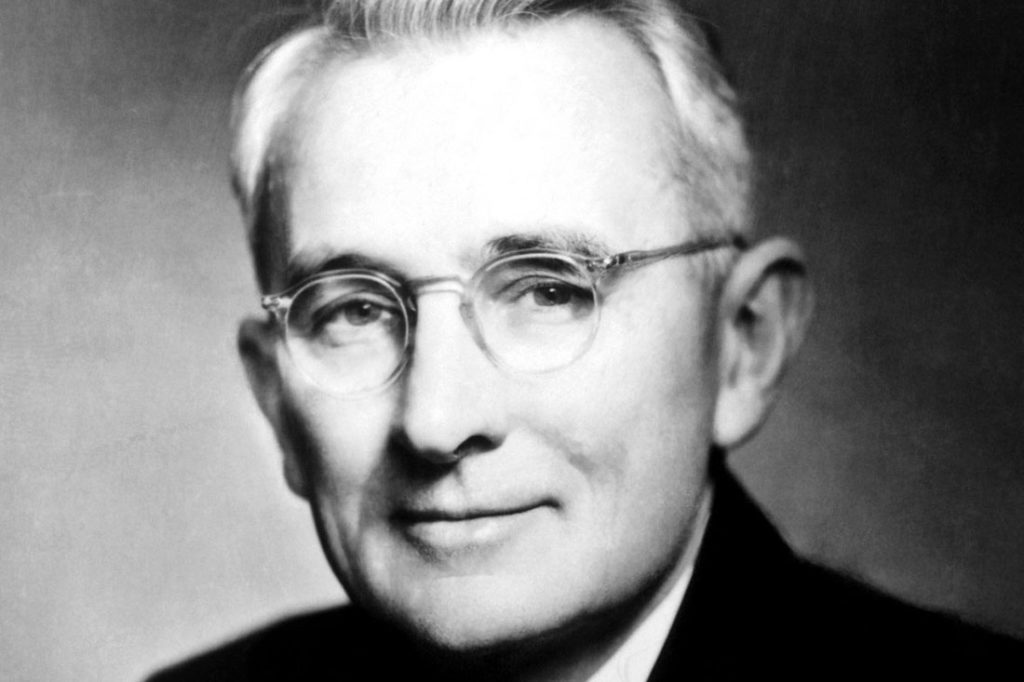Act enthusiastic, “smile,” “become genuinely interested in other people,” and “don’t criticize, condemn or complain.” When Dale Carnegie put those simple principles, among others, in a book called How to Win Friends and Influence People, he not only became a guru to millions of people the world over, he made publishing history. Since its first publication in 1936, the best-selling book has sold more than 15 million copies and is still popular today. Before there was an entire industry devoted to self-improvement, there was Carnegie and his desire to let people know their success depended largely on their ability to win friends and influence people.
Missouri values
In 1888, Carnegie was born into a life of hard times, hard work and failure. The Carnegies farmed an area in northwest Missouri that frequently flooded, and foreclosure was a constant threat. But Carnegie’s parents made it clear his future would be different.
The driving force in the Carnegie household was Dale’s mother, Amanda. A dynamic personality, she served as his mentor and personal-improvement coach. She saw great potential in his abilities and made it clear his destiny would not be the farmlands of Missouri. She knew the importance of confidence, good speaking skills and education, and encouraged Carnegie to give speeches in church.
At 16, Carnegie enrolled in the Missouri State Teachers College in Warrensburg, Missouri. To save money, he lived at home and helped his father with the chores every morning before putting on his only suit and walking to school.
After his junior year, Carnegie heard there was big money in sales, and landed a job in South Dakota with Armour & Company earning $17 a week. But when he was offered a management job, he turned it down, and decided to leave the Midwest for the big city lights of New York.
His dream was to become a novelist, working days selling Packard cars and trucks and writing at night. After struggling through his first book, which he declared a disaster, Carnegie decided he wasn’t cut out to be a novelist. At 24, it was time for self-reflection. He decided to do the next thing that came naturally to him: teach public speaking.
Finding his niche
In 1912, Carnegie got a job at the YMCA in Harlem teaching public speaking at night school. With no curriculum, he improvised, bringing students to the front of class to speak while he and the rest of the group offered encouragement and advice. Soon Carnegie’s courses were filled to capacity with people looking to conquer one of the most common fears—that of public speaking.
Carnegie said his courses were designed to train adults, through experience, to think on their feet and express their ideas with more clarity, effectiveness and poise. But as time passed, he realized these people also needed training in the art of getting along with others in everyday business and social situations. Industry was exploding as small businesses began turning into large enterprises. And along with this growth came a new breed of businessman: the middle manager who needed what Carnegie taught.
According to research published by the Carnegie Foundation, about 15% of one’s financial success is due to technical knowledge, and about 85% is due to skill in human engineering, personality and the ability to lead people. “One can always hire technical ability, but the person who has technical knowledge plus the ability to express ideas, to assume leadership and to arouse enthusiasm among people—that person is headed for higher earning power,” he said.
Putting principles on paper
Teaching courses on human relations, Carnegie searched in vain for a working handbook on the subject. So he started writing one for use in his own courses.
In preparation, he pored over newspaper columns, magazine articles, the writings of the old philosophers and countless biographies of great leaders to see how they dealt with people. At the same time, Carnegie started compiling a list of the core principles he taught in his courses, such as “don’t criticize, condemn or complain,” among others.
“Any fool can criticize, condemn and complain, but it takes character and self-control to be understanding and forgiving,” he said.
From this material he prepared a short talk, “How to Win Friends and Influence People.” For years, he gave this talk in his courses, urging his students to test it in their business and social settings and to report back at the next class. Carnegie said his students loved these assignments and were fascinated by the idea of working in the first and only laboratory of human relationships for adults.
What started as a few principles on a notecard grew to leaflets, then to a series of booklets, each principle expanding in size and scope until finally, after 15 years of experimentation and research, his book was ready.
Skills for better living
The timing for How to Win Friends and Influence People couldn’t have been better. Following the stock market crash in 1929, businesses and factories were shutting their doors and millions were out of work. Carnegie offered people a way to differentiate themselves by learning additional skills that would either open doors to new opportunities or keep them from being laid off.
Both Carnegie and publisher Simon & Schuster had modest expectations for the book, printing just 5,000 copies. Then an executive who had previously taken Carnegie’s course came up with the idea of selling the book to his seminar graduates.
Soon How to Win Friends and Influence People was flying off the shelves, selling an astounding 5,000 copies a day. Carnegie had provided a road map to show men and women from all walks of life how to connect with people and to influence others with dignity and respect.
Although he had critics who thought the book was filled with simplistic hyperbole, these attitudes were shared mostly by literary scholars, not mainstream America. The book sold so well it was translated into 30 languages and became a best-seller around the world. Soon “how to win friends and influence people” became a catchphrase, even used in cartoons and lampoons.
Humility in success
All of this newfound fame and fortune was a little overwhelming for the farm boy from Missouri. When his first royalty check for $90,000 arrived in the mail, he left it on his desk for a few days until his secretary prodded him to take it to the bank and deposit it.
With his success came more income-producing opportunities, including a syndicated column that appeared in more than 70 newspapers. He also had his own radio program broadcast nationwide.
Carnegie was recognized throughout the world, filling giant concert halls with people looking to learn from the master of human relations. His humility and Midwestern appeal made him a crowd favorite.
In the years following World War II, Carnegie penned another best-selling book, titled How to Stop Worrying and Start Living. Carnegie spent most of his time at home in Queens, New York, with his wife, Dorothy, whom he had met on one of his speaking tours years earlier. The couple also bought a large farm near his boyhood home in Missouri. Then, in 1951, Dorothy gave birth to a daughter, Donna Dale. At 63, Carnegie was a very wealthy man and a father for the first time.
It was just a few years later when Carnegie started to grow frail and began to forget things. In the summer of 1955 Carnegie returned one final time to his beloved Missouri, where he was awarded an honorary degree from his old college in Warrensburg. Just three months later, Carnegie died at the age of 66.
Humble even in death
For his final resting place, Carnegie had chosen the place he was born—the farm country of northwest Missouri. Shunning the spotlight even in death, it was Carnegie’s wish that not much be made of his passing. His gravestone simply reads “Dale Carnegie, 1888-1955.”
Long after his death, his legacy lives on. Carnegie’s work continues to attract some of the most successful people in the world. Former auto executive Lee Iacocca took the course, as did legendary investor Warren Buffett and Domino’s Pizza founder Tom Monaghan. They are among thousands who take his course each year. And nearly 90 years after it was published, How to Win Friends and Influence People continues to reach millions who want to learn the principles that can help them live better lives.
This article was published in February 2009 and has been updated. Photo by





